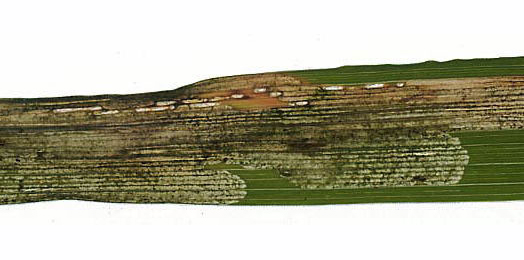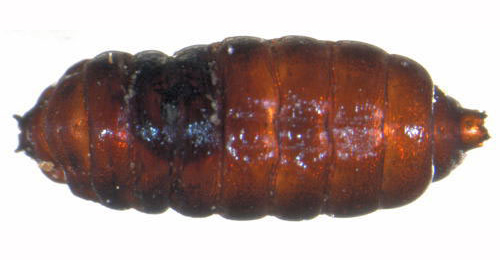|
||||||
| Agromyza
nigrociliata Hendel, 1931 [Diptera: Agromyzidae] |
|||||||||||||||||||||||||||||||||||||||||||||||||||||||||||||||
|
Agromyza
nigrociliata Hendel, 1931. Fliegen palaearkt. Reg.6 (2): 139 |
|||||||||||||||||||||||||||||||||||||||||||||||||||||||||||||||
Leaf-miner: The young larva first feeds towards the apex of the leaf, later turning and feeding downwards. Several larvae can occur together in a single leaf. Pupation external (Spencer, 1976: 130). Upper-surface, greenish, gradually widening corridor, at first running towards the leaf tip, then reverses. Through fusion of several mines the final mine is often communal. Frass in backish green grains, often washed out. Pupation outside the mine (Bladmineerders van Europa). Larva: The larvae of flies are leg-less maggots without a head capsule (see examples). They never have thoracic or abdominal legs. They do not have chewing mouthparts, although they do have a characteristic cephalo-pharyngeal skeleton (see examples), usually visible internally through the body wall. The larva is described by de Meijere (1925), Hering (1953), Darvas and Papp (1985) and Darvas, Skuhravá and Andersen (2000). Puparium: The puparia of flies are formed within the hardened last larval skin or puparium and as a result sheaths enclosing head appendages, wings and legs are not visible externally (see examples). Reddish-brown; posterior spiracles each with 3 bulbs (Spencer, 1976: 130). The puparium is illustrated in Bladmineerders van Europa.
Comments: A potentially serious pest on cereals. Hosts in Great Britain and Ireland:
Hosts elsewhere: Time of year - mines: June (Bladmineerders van Europa). Time of year - adults: June-July. Distribution in Great Britain and Ireland: Widespread in Britain including London (Hampstead), Surrey (Colley Hill, Epsom and Kew), Cornwall (Carbis Bay) (Spencer, 1972: 33), Midlothian (Morningside and Braiud Burn), Fife (Aberdour), Haddington (Aberlady), Dunbartonshire (Bonhill) (Bland, 1994c: 81), Warwickshire (Hartshill) (Robbins, 1991: 136), Cambridgeshire, Easterness, Elgin, Glamorgan, North Somerset, Nottinghamshire, Oxfordshire, South-west Yorkshire, Surrey, West Norfolk and West Sussex (NBN Atlas). Distribution elsewhere: Widespread in continental Europe including Denmark and Sweden (Spencer, 1976: 130), Belgium (Bladmineerders van Europa), Germany (Spencer, 1976: 546), Austria, Belarus, Czech Republic, Estonia, French mainland, Hungary, Lithuania, Poland, Slovakia, Spanish mainland and Switzerland (Fauna Europaea). Also recorded in the East Palaearctic (Fauna Europaea). NBN Atlas links to known host species:
British and Irish Parasitoids in Britain and elsewhere:
|
|
|
|
| External links: | Search the internet: |
|
Biodiversity Heritage Library Bladmineerders van Europa British leafminers Encyclopedia of Life Fauna Europaea NBN Atlas NHM UK Checklist |
Find
using Google Find using Google Scholar Find images using Google |
| Last updated 10-Oct-2019 Brian Pitkin | ||


